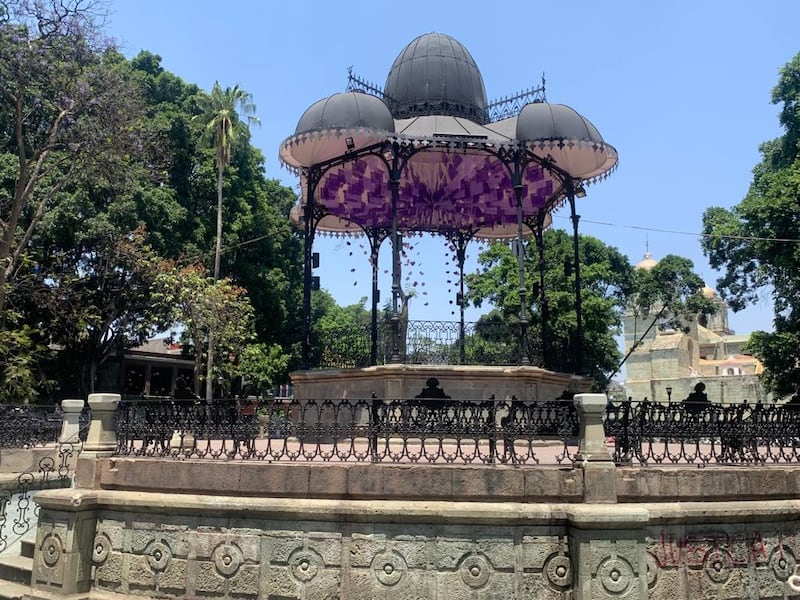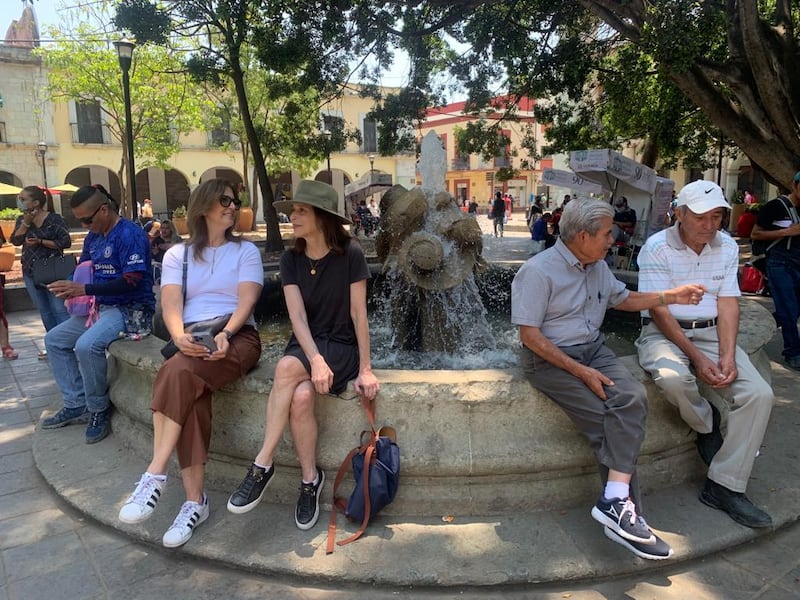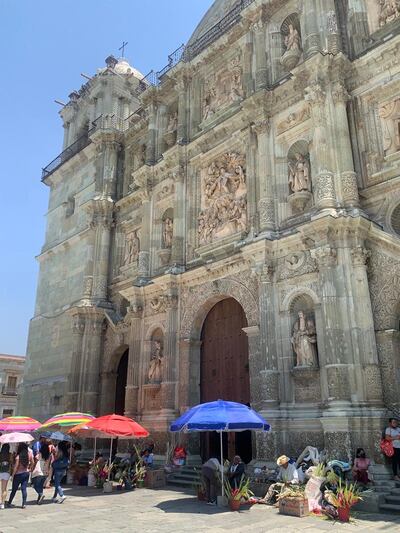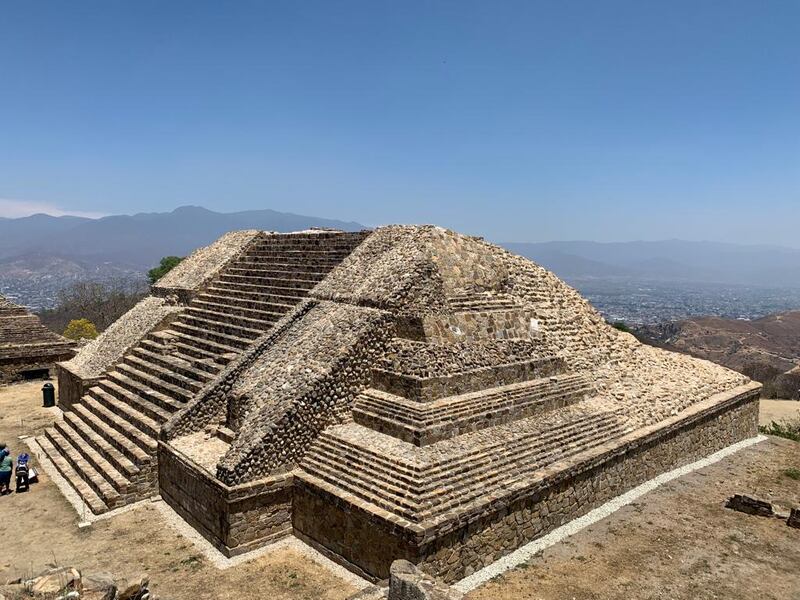It is Easter Week in Mexico, as it is in every other Christian country around the world. Easter in my childhood meant leaving Dublin for a Wicklow farm guest house run by Mrs Grace and called Seafield. It was a wonderful place, old world as we would see it now – Edwardian furnishings, starched linen table cloths and a big gong in the hall, standing at the foot of a giant wooden staircase, to announce that meals were being served. Though a working farm, it was a quiet place, away from the pressures of home and the city.
Easter week in Mexico is a bit of a riot – loud, long, brash and noisy, reflecting, I guess, the character of the country and its people. It is known here as Semana Santa and while it starts with Palm Sunday, it does not necessarily come to an end seven days later with Easter Sunday, the day of the resurrection. It can go on for another full week of religious ceremonies.
I came across the start of it all when I arrived on Oaxaca (pronounced Woh-Hacka). I got a pretty good hostel in the historic old town and headed quickly to the Plaza de la Constitución. The relief at realising, immediately, that I was in a real city – a big square with a really impressive and well cared for Victorian bandstand, mature trees and beds, a metropolitan cathedral dating back to 1535, and colonnades along two sides of the square, one length of which was home to restaurants and cafes.


It was early evening and the square was full of people – strolling, meeting friends for a chat, allowing children run a little wild with toys and sellers of everything imaginable, but mainly balloons and hats, tourist tat and ethnic throws.
What made the place really hop was the music – several mariachi groups (the Mexican guitar, brass, guitar bass, and trumpet ensembles) that perform for restaurant diners. They wear over-the-top wide-brimmed Mexican sombreros, very tight trousers, the outside legs of which are covered in silver-coloured studs, and waistcoat-cum-jackets that are several sizes too small and fail to cover a usually ample-sized tummy. They are a wonderful sight and are quintessentially Mexican. While Oaxaca gets most of its income these days from tourism (or so I read), these fellows were locals and doing their thing for audiences that were also overwhelmingly local, though not all from the city for sure. In other words, this wasn’t a pastiche; it was real.
Upon death, one attained immortality, which seems like a fairly good arrangement
Competing with them, if at another level style-wise, were two marimbas. These are xylophone-like percussion instruments played by two people (in this case, men) each holding a pair of small, circular mallets beating out a tune. As soon as the mariachi groups finished with a set of diners, the marimba fellows moved in and began their serenading. And all the time, children were running about, as were waiters, while diners chatted, enjoying themselves and full of laughter. It was wonderful; it was life.

The cathedral is enormous, like most Spanish colonial cathedrals. The heavily carved front facade was clean and bright and looked like it was made of sandstone. Inside, huge black basalt columns hold up a series of dome ceilings but the interior isn’t gaudy. In the cathedral in Pueblo, for instance, there is a very mawkish Spanish depiction of Christ in a glass sided coffin near the entrance, with particular attention paid to wounds, blood and rotting flesh. You can almost smell it.
For me, the most interesting thing about the cathedral was what was going on outside. There, groups of men and women were busy hand-making palm figures for Palm Sunday. Often these were simple weavings of palm leaves into vertical shapes, sometimes cross-like, sometimes just finished off with a coloured circle on top. The skills were quite like those needed to make good corn dollies and the men and women making them worked with great speed and skill. The end results were very pretty and most people were buying a couple.
[ Arriving in Mexico, it dawns on me this is a massive, massive countryOpens in new window ]
The next day, I went to Monte Alban, an ancient city on a hill above Oaxaca and the reason why the modern city will always have visitors. Monte Alban dates back to 500BC – that is, to the time of Periclean Athens – and thrived until 850 AD when it ceased to be, for reasons not entirely known.
Monte Alban was built by the Zapotec people, indigenous Mexicans that at one time dominated the Oaxaca valley. Today, there are about half a million Zapotec people around, most of them in this region. Monte Alban was created as a ceremonial centre so that the Zapotec ruling elite could consolidate their position. The city dominates the highest position above the plain that was farmed and on which people depended for food.
When I turned 60, 10 years ago, I hated that. None of the previous 59 birthdays impacted me in the way that one did
The city, as it looks today, is not dissimilar to other ancient indigenous settlements of religious significance in Central America – be they Mayan or Inca. It is rectangular in shape and is, by my estimation, about 1,000m long by 250m wide. Many of the buildings look like decapitated pyramids – shallow sided, with steps leading to large flat areas that were, in some cases, altars or stages for religious ceremonies. The interest in height, as a location for the city and the focal point for religious ceremonies, was because the Zapotecs thought it brought them closer to god. Upon death, one attained immortality, which seems like a fairly good arrangement, and one’s remains were delivered immediately to the gods who accompanied them in their tombs ... of which there are a fair few on Monte Alban.
The Zapotecs were interested in the calendar and the cosmos, in science and the arts. All around, though not always easy to see, are carvings in stone. The city is built on a north/south axis, so the sun rises on one side and sets on the other. With a Gran Plaza, ball court, palace and what is described as a gallery of the dancers, it doesn’t appear that ordinary people lived here. There are too many tombs and buildings devoted to religion for there to have been any significant cohort living here. They, it seems, lived in the lowlands, farming and getting on with life, while others kept the gods happy... up the mountain.

On matters ancient, I am 70 as of today, April 9th, 2023.
I’ve never been 70 before, so I’m not really sure what to make of it. It’s a first for me. I’m well aware that it has happened to others but just not to me. And I don’t think I much like it. When I turned 60, 10 years ago, I hated that. None of the previous 59 birthdays impacted me in the way that one did and so I expect I should feel everything I felt then, plus another 16.6 per cent of Eeyore-ish gloom. I do.
I remember thinking, when my Dad turned 70, “Christ, he’s really the Old Man now”. And yet, he went on for another 20 years, which was fairly amazing, and most of it okay-ish. Only the last six or eight years were a bit grim as his eyes and chest let him down, and he lost his wife, my much missed Mum. But even then, he lived with one of his children – me and my family – and was visited regularly by his others, until about four months before the end. He wasn’t alone.
If I am as lucky as my Dad, this is what awaits – an inexorable decline, bits starting to fail, like an old banger car, watching contemporaries die and dwelling on the abyss of ‘I’ll never see them again’
I know that I should really be writing something saying how lucky I am. And I am. Lucky, that is. I’m in good health – as far as I know – and reasonably fit, though a lot less so compared to a few years back. I can still hop over a wall, vault a five bar gate and shinny up most mountains in Ireland without much bother.
Getting dressed in the morning, I practice standing on one foot to put my socks on and can still do it. Such small triumphs are not to be sniffed at when you are 70. And here I am riding an enormous motorbike, a BMW R1200 GS Adventure, through the Americas. But it is the realisation that, if I am as lucky as my Dad, this is what awaits – an inexorable decline, bits starting to fail, like an old banger car, watching contemporaries die and dwelling on the abyss of “I’ll never see them again”, watching the generation below making the same mistakes (or worse) that we did and railing at the radio... a burden to others.
[ Nicaragua: First impressions were good. Then I got pulled over by the policeOpens in new window ]
[ ‘What the feck are you at?’ I’ve asked myself at times over the last 14,000kmOpens in new window ]
The night before leaving the hostel in which I stayed in Antigua, Guatemala, I sat up for a time chatting to two young women from Israel. They were lovely people – full of vigour and enthusiasm; interested in the world about them and not slow to say what they thought, especially about the current Israeli prime minister, Binyamin Netanyahu. The next morning when I was leaving, I sought them out to say goodbye and wish them well (they were about to return home to begin third level). We hugged and one of them said to me: “Stay young.”
I took it to mean that she thought I was young for my age and so, yes, that’s what I’ll do. Carry on, grateful for having a wonderful, kind, talented and tolerant wife whom I love, and two healthy children fashioning their own futures. Now, where did I leave the bike keys and the map...
Peter Murtagh is travelling by motorbike from Tierra del Fuego, at the tip of South America, to Alaska, at the top of North America, and writing here regularly. You can also read his blog and follow him on Twitter, Facebook and Instagram











